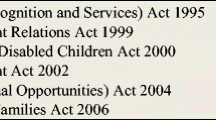Abstract
Caring for elderly people is a struggle for most public sector organisations around the world. Especially troublesome is the task of attracting, recruiting, and retaining competent employees to work in the elderly care sector (Johansson & Moss, 2004; National Commission on Nursing Workforce for Long-Term Care, 2005).
Access this chapter
Tax calculation will be finalised at checkout
Purchases are for personal use only
Preview
Unable to display preview. Download preview PDF.
Similar content being viewed by others
References
Allen, D. G. (2006). Do organizational socialization tactics influence newcomer embeddedness and turnover? Journal of Management, 32(2), 237–256.
Benjamin, A. E., Matthias, R. E., Keitzman, K., & Furman, W. (2008). Retention of paid related caregivers: Who stays and who leaves home care careers? The Gerontologist, 48, 104–113.
Boswell, W. R., Roehling, M. V., LePine, M. A., & Moynihan, L. M. (2003). Individual job-choice decisions and the impact of job attributes and recruitment practices: A longitudinal field study. Human Resource Management, 42(1), 23-37.
Breaugh, J. A., & Starke, M. (2000). Research on employee recruitment: So many studies, so many remaining questions. Journal of Management, 26(3), 405–434.
Buchan, J. (2004). What difference does (“good”) HRM make? Human Resources for Health, 2(6), 1–7.
Cable, D. M., & Turban, D. B. (2003). The value of organizational reputation in the recruitment content: A brand-equity perspective. Journal of Applied Social Psychology, 33(11), 2244–2266.
Cappelli, P. (2000). A market driven approach to retaining talent. Harvard Business Review, 78(1), 103–110.
Carless, S. A. (2005). Person-job fit versus Person-organization fit as predictors of organizational attraction and job acceptance: A longitudinal study. Journal of Occupational and Organizational Psychology, 78(3), 411–429.
Carless, S. A., & Wintle, J. (2007). Applicant attraction: The role of recruiter function, work-life balance policies and career salience. International Journal of Selection and Assessment, 15(4), 394–404.
Castle, N. G., & Engberg, J. (2006). Organizational characteristics associated with staff turnover in nursing homes. The Gerontologist, 46(1), 62–73.
Chou, R. J. A. (2012). Resident-centered job satisfaction and turnover intent among direct care workers in assisted living: A mixed-methods study. Research on Aging, 34(3), 337–364.
Dhar, R. L. (2013). Reality shock: Experiences of Indian Information Technology (IT) professionals. Work: A Journal of Prevention, Assessment and Rehabilitation, 46(3), 251–262.
Ellenbecker, C. H. (2004). A theoretical model of job retention for home health care nurses. Journal of advanced nursing, 47(3), 303–310.
Ellström, E. (2012). Managerial support for learning at work: a qualitative study of first-line managers in elder care. Leadership in Health Services, 25(4), 273–287.
Heilmann, P. A. (2010). Employer brand image in a health care organization. Management Research Review, 33(2), 134–144.
Henkens, K., Remery, C., & Schippers, J. (2008). Shortages in an ageing labour market: An analysis of employers’ behaviour, International Journal of Human Resource Management, 19(7), 1314–1329.
Johansson, S., & Moss, P. (2004). Work with elderly people. A case study of Sweden, Spain and England with additional material from Hungary. Consolidated report. Care work in Europe. Current understandings and future directions. Retrieved April 16, 2009 from http://www8.umu.se/socw/forskning/WP9%20consolidated%20report.pdf
Johnson, M., & Roberts, P. (2006). Rules of attraction. Recruit and retain the best staff with employer branding. Marketing Health Services, 26(1), 38–40.
Kabene, S. M., Orchard, C., Howard, J. M., Soriano, M. A., & Leduc, R. (2006). The importance of human resource management in health care: a global context. Human Resources for Health, 4(20), 1–17.
Martin, G., Beaumont, P., Doig, R., & Pate, J. (2005). Branding: A new performance discourse for HR? European Management Journal, 23(1), 76–88.
McNeese-Smith, D. K. (2001). A nursing shortage: Building organizational commitment among nurses. Journal of Healthcare Management, 46, 173–186.
Mintzberg, H. (1998). The strategy concept. Five Ps for strategy. In H. Mintzberg, J. B. Quinn, & S. Ghoshal (Eds.), The strategy process (pp. 13–21). Oxford: Prentice Hall.
Monahan, R. S., & McCarthy, S. (1992). Nursing home employment: The nurse’s aide’s perspective. Journal of Gerontological Nursing, 18(2), 13–16.
National Commission on Nursing Workforce for Long-Term Care. (2005). Act now for your tomorrow. Retrieved February 25, 2009 from http://www.gwumc.edu/sphhs/departments/healthpolicy/chsrp/downloads/FinalCommissionReport051105.pdf
Nilsson, P., Wallo, A., Rönnqvist, D., & Davidson, B. (2011). Human resource development: Attutveckla medarbetare och organisationer (Human resource development: Developing co-workers and organisations). Lund: Studentlitteratur.
Osborne, S. E. (2001). Recruitment: Whose job is it anyway? Advances in Neonatal Care, 1(1), 59–61.
Pinnington, A., & Edwards, T. (2000). Introduction to human resource management, Oxford: Oxford University Press.
Price, A. (2011). Human resource management. Andover: Cengage Learning EMEA.
Sellgren, S., Ekvall, G., & Tomson, G. (2007). Nursing staff turnover: Does leadership matter? Leadership in Health Services, 20(3), 169–183.
Schein, E. H. (1988). Organizational psychology. Englewood Cliffs: Prentice-Hall.
Statistics Sweden. (2011). Trender & Prognoser 2011. Befolkningen, utbildningen och arbetsmarknaden med sikte på år 2013 (Trends & Forecasts 2011. Population, education and labour market in Sweden – outlook to year 2013). Stockholm: Statistics Sweden.
Thomas, K. M., & Wise, P. G. (1999). Organizational attractiveness and individual differences: Are diverse applicants attracted by different factors, Journal of Business and Psychology, 13(3), 375–390.
Torrington, D., Hall, L., & Taylor, S. (2008). Human resource management. Harlow: Pearson Education.
Tran, D., Davis, A., McGillis Hall, L., & Jaglal, S. B. (2012). Comparing recruitment and retention strategies for rehabilitation professionals among hospital and home care employers. Physiotherapy Canada, 64(1), 31–41.
Van Hoye, G. (2012). Recruitment sources and organizational attraction: A field study of Belgian nurses. European Journal of Work and Organizational Psychology, 21(3), 376–391.
Author information
Authors and Affiliations
Editor information
Editors and Affiliations
Rights and permissions
Copyright information
© 2015 Sense Publishers
About this chapter
Cite this chapter
Rönnqvist, D., Wallo, A., Nilsson, P., Davidson, B. (2015). Employee Resourcing In Elderly Care. In: Bohlinger, S., Haake, U., Jørgensen, C.H., Toiviainen, H., Wallo, A. (eds) Working and Learning in Times of Uncertainty. Research on the Education and Learning of Adults. SensePublishers, Rotterdam. https://doi.org/10.1007/978-94-6300-244-8_10
Download citation
DOI: https://doi.org/10.1007/978-94-6300-244-8_10
Publisher Name: SensePublishers, Rotterdam
Online ISBN: 978-94-6300-244-8
eBook Packages: Humanities, Social Sciences and LawEducation (R0)




